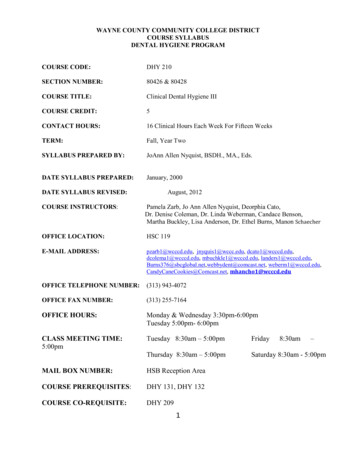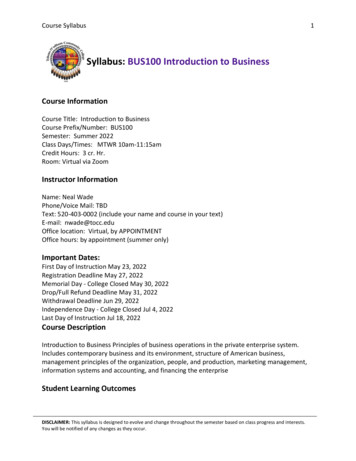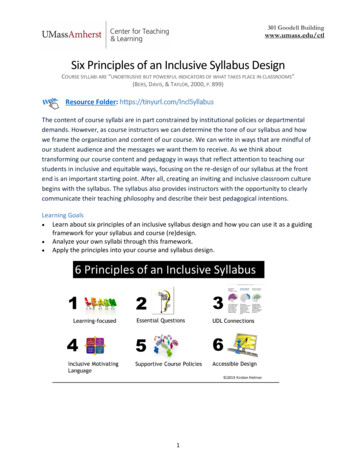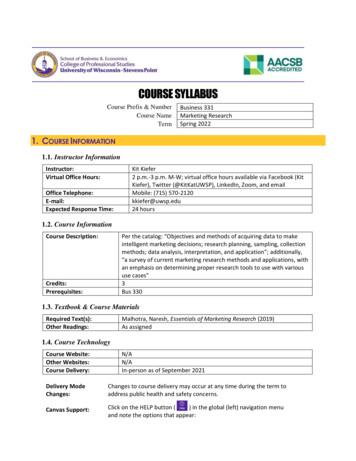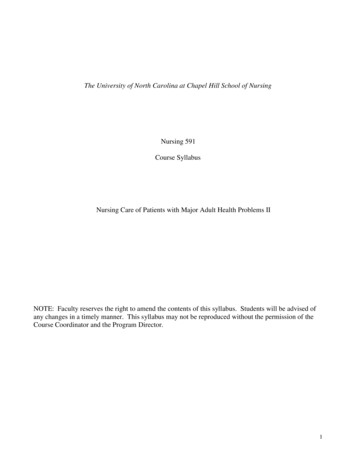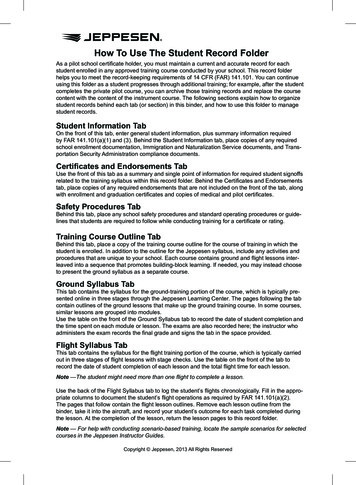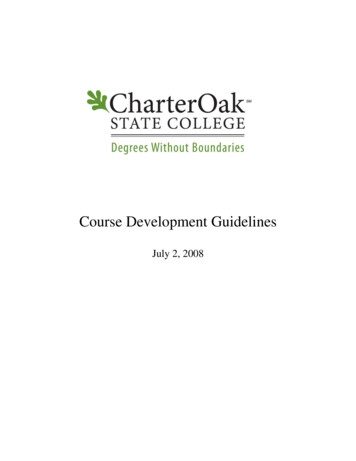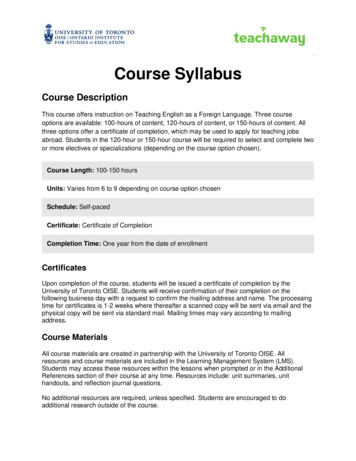
Transcription
.Course SyllabusCourse DescriptionThis course offers instruction on Teaching English as a Foreign Language. Three courseoptions are available: 100-hours of content, 120-hours of content, or 150-hours of content. Allthree options offer a certificate of completion, which may be used to apply for teaching jobsabroad. Students in the 120-hour or 150-hour course will be required to select and complete twoor more electives or specializations (depending on the course option chosen).Course Length: 100-150 hoursUnits: Varies from 6 to 9 depending on course option chosenSchedule: Self-pacedCertificate: Certificate of CompletionCompletion Time: One year from the date of enrollmentCertificatesUpon completion of the course, students will be issued a certificate of completion by theUniversity of Toronto OISE. Students will receive confirmation of their completion on thefollowing business day with a request to confirm the mailing address and name. The processingtime for certificates is 1-2 weeks where thereafter a scanned copy will be sent via email and thephysical copy will be sent via standard mail. Mailing times may vary according to mailingaddress.Course MaterialsAll course materials are created in partnership with the University of Toronto OISE. Allresources and course materials are included in the Learning Management System (LMS).Students may access these resources within the lessons when prompted or in the AdditionalReferences section of their course at any time. Resources include: unit summaries, unithandouts, and reflection journal questions.No additional resources are required, unless specified. Students are encouraged to doadditional research outside of the course.
.Technical SupportFor technical support regarding the course, please contact Teach Away Support.Reflection Journals & AssessmentsVarious assessments within the course are used to test students’ knowledge of what they havelearned within the units as well as reflect on their own experiences and reasons for wanting toteach abroad.Course assessments include the following:Practice Assessments: These assessments are included within the lesson files themselvestest learner knowledge of what they’ve learned within that lesson. These assessments maybe short answer questions, multiple choice, fill in the blanks, matching or any other type ofresponse. These assessments are not graded; however, a passing grade of 80% must beachieved in order to move onto the next lesson.Reflection Journals: Reflection journals require students to reflect on what they’ve learnedwithin the unit. Reflection Journals are due at the end of each core unit and are marked dailybetween 9am and 5pm EST. Students must receive a passing grade of 100% in order tocontinue with their learning.Unit Assessments: Each unit includes a final assessment that requires students to reflecton what they’ve learned throughout the unit. All questions are pulled from practiceassessments used throughout the unit. Students must receive a minimum of 70% in order tocontinue with their learning. After a failed attempt, assessments are locked and are unlockedevery 48 hours. During this time, students are encouraged to review the materials within theunit.Final Assessment: After the successful completion of all core units, students will berequired to complete a final assessment comprised of 70 questions. All questions are pooledfrom assessments students will have completed earlier in the course. Students must receivea minimum of 70% in order to complete their certificate. After a failed attempt, assessmentsare locked and are unlocked every 48 hours. During this time, students are encouraged toreview the materials within the course.
.Course BreakdownCore UnitsUnit 1: An Introduction to English Language TeachingApproximate length: 10 hoursAssignments: practice assessments, reflection journals, and a unit assessment (passrequired to move on within the course)Lesson 1: The World of EnglishLesson 2: How English WorksLesson 3: ESL & EFLLesson 4: Principles of Second Language Acquisition Part ILesson 5: Principles of Second Language Acquisition Part IILesson 6: Principles of Second Language Acquisition Part IIILesson 7: Language Acquisition in the ClassroomLesson 8: Language Teaching MethodsUnit focus: This unit discusses the function of English as a global language and thestructure of the language itself. The unit will answer the following questions: Why doesEnglish function as it does? Which learning methods work best around the world?Throughout the unit, students will learn about: The role of English as a global language Principles of second language acquisition Teaching methodsUnits 2: Teaching Language Skills Parts 1 & 2Approximate length: 25 hoursAssignments: practice assessments, reflection journals, and a unit assessment (passrequired to move on within the course)Teaching Language Skills Part 1Lesson 1: Preparing the Language Learning EnvironmentLesson 2: Supporting the Language Learning EnvironmentLesson 3: Teaching StrategiesLesson 4: Teaching Productive SkillsLesson 5: Teaching Receptive SkillsLesson 6: Assessment
.Teaching Language Skills Part 2Lesson 1: Defining GrammarLesson 2: Approaching GrammarLesson 3: Form-Focused InstructionLesson 4: WordsLesson 5: Strategic GrammarLesson 6: Verbs: Kinds, Voice, AspectLesson 7: Verbs and TenseLesson 8: ConditionalsLesson 9: Modal VerbsLesson 10: Words and PhrasesLesson 11: ClausesLesson 12: SentencesLesson 13: Common ErrorsUnit focus: This unit covers the basics of teaching language skills to English LanguageLearners. The unit focuses on creating student-centred lesson plans, which elements ofEnglish can be difficult for students to learn, and how these difficulties can be addressed inthe classroom.Throughout the unit, students will learn about: The Dos and Don’ts of ESL/EFL Introducing activities, giving instructions, and assessing student comprehension Providing feedback and correcting student errors Teaching the six major elements of language learning: reading, writing, speaking,listening, grammar, and pronunciationUnit 3: Adapting Subject-Specific ContentApproximate length: 10 hoursAssignments: practice assessments, reflection journals, and a unit assessment (passrequired to move on within the course)Lesson 1: Teaching ScenariosLesson 2: Types of LanguageLesson 3: Examining Subject-Specific VocabularyLesson 4: Teaching Skills in the Content AreasUnit focus: This unit focuses on practicing flexibility with content and identifying thesituations in which lessons should be adapted. The unit will answer the following questions:How can a teacher adjust the curriculum to bridge gaps in students’ abilities? How will thisvary in different regions?Throughout the unit, students will learn about: Ways to adapt curriculum content
. How to adjust expectationsHow to use subject content to teach English language skillsUnit 4: Structuring and Delivering LessonsApproximate length: 20 hoursAssignments: practice assessments, reflection journals, and a unit assessment (passrequired to move on within the course)Lesson 1: Effective Lesson PlanningLesson 2: Strategies to Use While Teaching LessonsLesson 3: Supporting Student UnderstandingLesson 4: Lesson Plan Building BlocksLesson 5: Instruction and AssessmentLesson 6: Knowing Students and Anticipating NeedsLesson 7: Planning Activities for StudentsLesson 8: Adult Lesson PlanLesson 9: Adolescent Lesson PlanLesson 10: Lesson CritiqueUnit focus: This unit guides students through the process of developing the components ofa successful lesson. Students will learn how to identify classroom themes and channelstudent attention into productive learning. This unit will answer the question: How caneducators assess their own lessons in order to improve?Throughout the unit, students will learn about: Identifying individual needs Defining learning objectives Using supplementary resourcesUnit 5: Managing Your Teaching EnvironmentApproximate length: 25 hoursAssignments: practice assessments, reflection journals, and a unit assessment (passrequired to move on within the course)Lesson 1: Managing the Teaching / Learning EnvironmentLesson 2: Multiple Intelligence TheoryLesson 3: Before-During-After Planning FrameworkLesson 4: “Before” Teaching ToolsLesson 5: “During” Teaching ToolsLesson 6: “During” and “After” Teaching Tools
.Lesson 7: Instructional PracticeLesson 8: Teaching Tools in Different ContextsLesson 9: Instructional ComponentsLesson 10: Assessment for LearningLesson 11: Assessment Methods and DifferentiationLesson 12: Community Building and Classroom ManagementLesson 13: Community Building and Classroom Management Part 2Lesson 14: Community Building and Classroom Management Part 3Lesson 15: Creating a Safe Learning EnvironmentUnit focus: This unit covers classroom management and teaches how to adapt to theneeds and students’ different learning styles. Classroom techniques vary substantiallyacross the world. This unit will answer the question: Which techniques remain constant in allregions?Throughout the unit, students will learn about: Adapting to different learning styles The importance of planning Setting and maintaining high expectations of behaviourUnit 6: Resources and MaterialsApproximate length: 10 hoursAssignments: practice assessments and a unit assessment (pass required to move onwithin the course)Lesson 1: Selecting MaterialsLesson 2: Adapting MaterialsLesson 3: Essential ResourcesLesson 4: Authentic MaterialsLesson 5: Online ResourcesLesson 6: Ongoing Professional DevelopmentUnit focus: This unit introduces methods of finding, adapting, and personalizing teachingmaterials. It answers the question: How can teachers adapt materials to meet the needs ofEnglish Language Learners?Throughout the unit, students will learn about: Selecting and adapting a wide variety of text-based and digital resources Building a varied toolbox of teaching materials Engaging in basic teaching reflection and research
.Elective/Specialization UnitsStudents in the 120-hour may choose any two of the units listed below. Students in the 150-hourcourse will automatically be enrolled in the following units: Digital Technology in the Classroom,Learner-Centred Classrooms, and Teaching Abroad. Students in the 150- hour course maychoose any two additional elective units.Students who did not choose their electives/specializations upon enrollment should email theirselection to teflonline@teachaway.com and await a response from the Course Advisors.Elective Unit: Teaching English to Korean SpeakersApproximate length: 10 hoursAssignments: practice assessments and a unit assessment (pass required to move onwithin the course)Lesson 1: An Introduction to Korean Speakers of EnglishLesson 2: English and Korean Vowel SystemsLesson 3: English and Korean Consonant SystemsLesson 4: Consonant ClustersLesson 5: Korean and English Word StressLesson 6: Short English Vowels and Korean SpeakersLesson 7: Spelling PatternsLesson 8: VocabularyLesson 9: Verb ComplementationLesson 10: English and Korean Verb TensesLesson 11: Knowledge in ActionUnit focus: This unit will help students become familiar with the common difficulties nativeKorean speakers face when they enter and English language classroom, as well as suggestactivities and techniques to help students overcome these difficulties.Throughout the unit, students will learn about: Recognizing common phonological errors to help improve Korean speakers’pronunciation of English vowels, diphthong, and consonants Counteracting the problems caused by differences in syntax and morphologybetween Korean and English Improving students’ use of English tenses and verbs Adapting teaching styles and classroom management techniques to better suit theculture of Korean-speaking studentsElective Unit: Teaching English to Arabic Speakers
.Approximate length: 10 hoursAssignments: practice assessments and a unit assessment (pass required to move onwithin the course)Lesson 1: An Introduction to Arabic Speakers of EnglishLesson 2: Arabic and English VowelsLesson 3: Language TransferLesson 4: Arabic Speakers and ConsonantLesson 5: Word Stress and MeaningLesson 6: English Spelling PatternsLesson 7: Spelling PatternsLesson 8: Derivation and Spelling PatternsLesson 9: SyntaxLesson 10: Knowledge in ActionUnit focus: Throughout this unit, students will become familiar with the common difficultiesnative Arabic speakers face when they enter an English language classroom, as well asactivities and techniques to help students overcome these difficulties.Throughout the unit, students will learn about: Recognizing common phonological errors to help improve Arabic speakers’pronunciation of English vowels, diphthongs and consonants Counteracting the problems caused by differences in syntax and morphologybetween Arabic and English Improving students’ use of English tenses and verbs Adapting teaching style and classroom management techniques to better suit theculture of Arabic-speaking studentsElective Unit: Teaching English to Mandarin (Chinese) SpeakersApproximate length: 10 hoursAssignments: practice assessments and a unit assessment (pass required to move onwithin the course)Lesson 1: An Introduction to Mandarin Speakers of EnglishLesson 2: Mandarin and English VowelsLesson 3: The Mandarin Consonant SystemLesson 4: Consonant ClustersLesson 5: Mandarin and English Word StressLesson 6: Short English Vowels and Mandarin SpeakersLesson 7: Spelling PatternsLesson 8: VocabularyLesson 9: Verb ComplementationLesson 10: English and Mandarin Verb TensesLesson 11: Knowledge in Action
.Unit focus: In this unit, students will become familiar with the common difficulties nativeMandarin speakers face when they enter an English language classroom, as well asactivities and techniques to help students overcome these difficulties.Throughout the unit, students will learn about: Recognizing common phonological errors to help improve Mandarin speakers’pronunciation of English vowels, diphthongs and consonants Counteracting the problems caused by differences in syntax and morphologybetween Mandarin and English Improving students’ use of English tenses and verbs Adapting teaching styles and classroom management techniques to better suit theculture of Mandarin-speaking studentsElective Unit: Teaching English to Young LearnersApproximate length: 10 hoursAssignments: practice assessments and a unit assessment (pass required to move onwithin the course)Lesson 1: Understanding Second-Language DevelopmentLesson 2: Being and Effective TeacherLesson 3: Lesson DesignLesson 4: Teaching Listening and SpeakingLesson 5: Teaching Reading and WritingLesson 6: Vocabulary and GrammarLesson 7: Engaging LearnersLesson 8: Using ICTLesson 9: AssessmentLesson 10: What If?Unit focus: Teaching young learners presents its own set of challenges no matter thelanguage of instruction. Traditional language learning principles are often geared towardadults. Throughout this unit, students will learn how to apply these principles withapproaches that work best in young learners’ classrooms.Throughout the unit, students will learn about: Designing a balanced lesson aimed at young learners Engaging young learners through a variety of media, activities, and teachingtechniques How to effectively teach the major language skills as well as grammar andvocabulary to young learners Strategies to properly incorporate technology in the classroom How to assess young learners
.Elective Unit: Teaching Test Preparation CoursesApproximate length: 10 hoursAssignments: practice assessments and a unit assessment (pass required to move onwithin the course)Lesson 1: English Language Proficiency TestsLesson 2: Getting Familiar with ELPTsLesson 3: Planning and Organizing Test Preparation CoursesLesson 4: Test Teaching StrategiesLesson 5: Teaching Vocabulary for Test PreparationLesson 6: Preparing Students for Reading TestsLesson 7: Writing Skills for TestsLesson 8: Listening and Speaking TestsLesson 9: Testing in Your ClassroomLesson 10: Teaching Test Taking StrategiesUnit focus: In this unit, students are introduced to the structure and function of Englishlanguage tests worldwide. Participants are taught strategies to provide students with usefulstudy tools for major English language tests.Throughout the unit, students will learn about: Identifying and teaching key features of major proficiency tests Planning and organizing a test preparation course Preparing students for reading, writing, speaking, and listening tasks Teaching vocabulary and grammar in a way that meets test requirements Teaching successful test-taking strategiesElective Module: Teaching Business EnglishApproximate length: 10 hoursAssignments: practice assessments and a unit assessment (pass required to move onwithin the course)Lesson 1: An Introduction to Business EnglishLesson 2: Designing a Business English CourseLesson 3: Using English in Business SituationsLesson 4: Developing Oral Communication SkillsLesson 5: Effective Communication in Business SituationsLesson 6: Incorporating Job Interview Scenarios and Case StudiesLesson 7: Business English Teaching MaterialsLesson 8: Cultural Differences in the Global WorkplaceLesson 9: Business WritingLesson 10: Evaluation and Assessment
.Unit focus: This unit covers the foundations of Business English teaching. English is thelanguage of international business. As the world grows increasingly smaller, the role ofEnglish in business grows even larger. Professionals around the world use English either asa first language or as a common second language.Throughout the unit, students will learn about: Designing and implementing a Business English course Teaching business language and industry jargon Helping students practice communicating in a business environment Properly adapting material to be culturally appropriate Assisting students in writing business correspondenceElective Unit: Digital Technology in the ClassroomApproximate length: 10 hoursAssignments: practice assessments and a unit assessment (pass required to move onwithin the course)Lesson 1: Foundations of TechnologyLesson 2: Integrating Technology ToolsLesson 3: Learning Management SystemsLesson 4: Digital Social MediaLesson 5: Project-Based LearningLesson 6: Issues & ChallengesUnit focus: In this unit, students will explore the use of new technologies and meaningfulways in which these can be used to improve their students’ learning practices.Throughout the unit, students will learn about: Incorporating a wide variety of technology into the classroom to positively impact thelearning process Using technology tools to teach reading, writing, speaking, and listening Using social media to teach English Establishing a project-based learning strategy using digital tools The positives and negatives of incorporating digital tools, learning managementsystems, and social media within the classroomElective Unit: Learner-Centred ClassroomsApproximate length: 10 hours
.Assignments: practice assessments and a unit assessment (pass required to move onwithin the course)Lesson 1: Creating the Learning EnvironmentLesson 2: Implementing the 5 Ms of Student LearningLesson 3: Behaviour Structures, Codes and ConventionsLesson 4: Differentiated InstructionLesson 5: Using Student Choice ActivitiesLesson 6: Introducing Vygotsky and FlowLesson 7: Immersion to IndependenceLesson 8: Cooperative and Collaborative Learning StructuresLesson 9: Teaching NoticingLesson 10: Language Exploration ActivitiesUnit focus: In this unit, students will learn how to give students control of content andlanguage output. This unit also covers how to teach discovery and noticing techniques tohelp students become more independent learners.Throughout the unit, students will learn about: Creating a friendly learner-centred classroom Teaching behaviour structures Using student choice activities Introduce cooperative and collaborative learning structures into the classroom Teaching noticing skills and use language exploration activitiesElective Unit: Teaching AbroadApproximate length: 10 hoursAssignments: practice assessments and a unit assessment (pass required to move onwithin the course)Lesson 1: Teaching AbroadLesson 2: Cross-cultural Working & LivingLesson 3: Finding a Job & Preparing for Life AbroadUnit focus: This unit equips new teachers with the knowledge to research destinations,organizations, and work environments overseas. International contracts and business normsmay differ vastly from those in the teacher’s home country. By learning to address commondifficulties and misconceptions when teaching abroad.Throughout the unit, students will learn about: Researching destinations and work environments for teachers abroad Resume and interview preparation
Course Syllabus Course Description This course offers instruction on Teaching English as a Foreign Language. Three course options are available: 100-hours of content, 120-hours of content, or 150-hours of content. All three options offer a certificate of completion, which may be used to apply for teaching jobs abroad.




